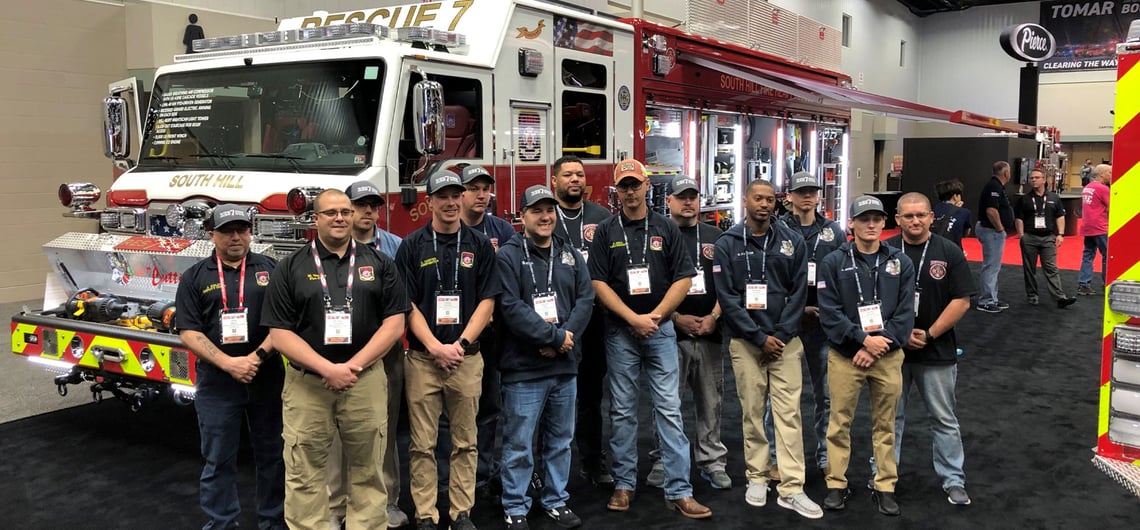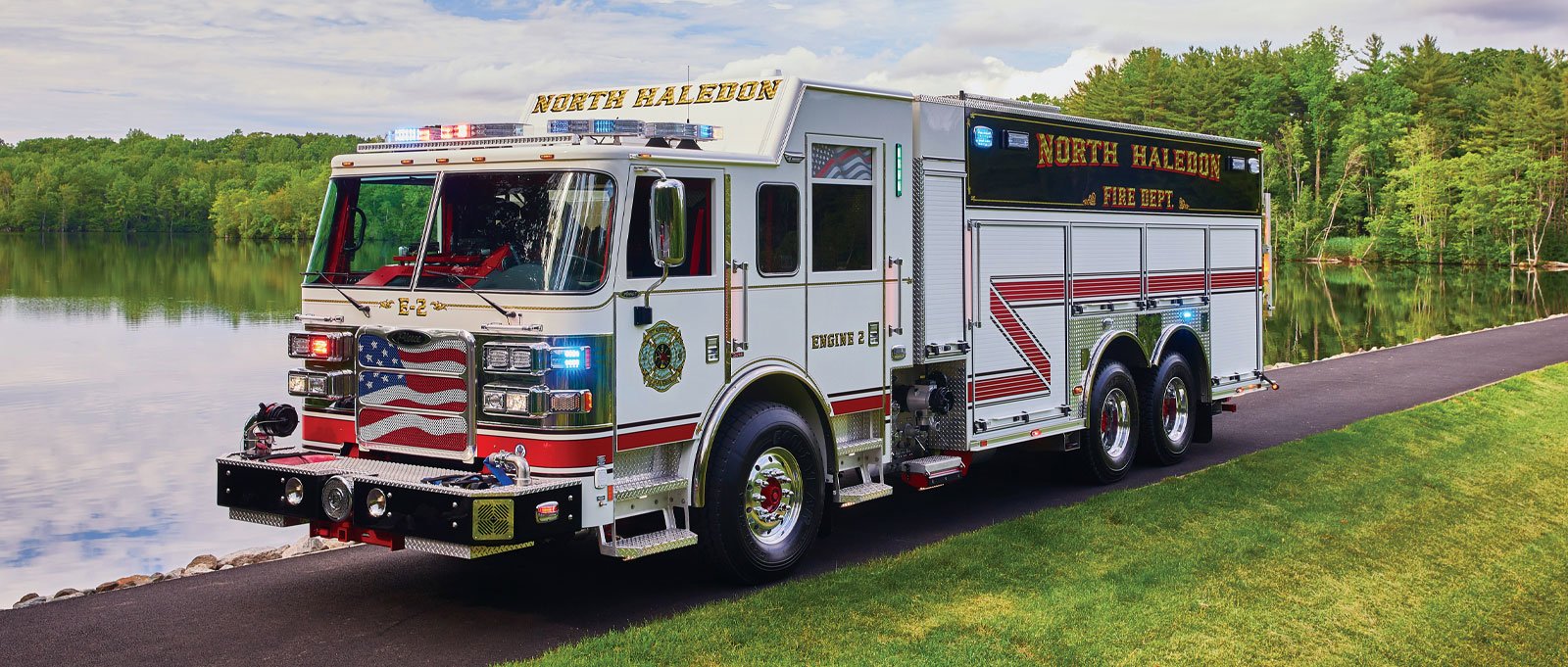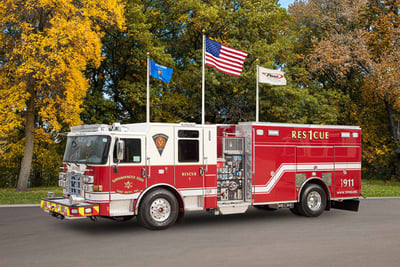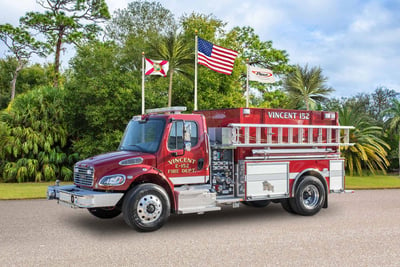
According to the National Fire Department Registry data updated in 2024, nearly 85% of fire departments in the United States are reported as volunteer or mostly volunteer departments.
Volunteer fire departments provide crucial support in many communities and to maintain effectiveness, efficiency is key.
This blog will review some of the main challenges volunteer fire departments face and how apparatus can be used to support these challenges and enhance efficiency.
What Are the Differences Between Career and Volunteer Fire Departments?
Career firefighters and volunteer fire departments share the common goal of protecting communities from fires and emergencies, but there are several differences in firefighters’ roles, training and time commitment.
- Volunteer Fire Departments are often smaller and have fewer resources, relying on a combination of volunteers and, in some cases, a smaller number of career personnel.
- Volunteer firefighters are community members who serve voluntarily and may have other primary occupations.
- Volunteer firefighters respond to emergencies when available, often outside regular working hours. Response times may vary, particularly during working hours.
Both career and volunteer firefighters play vital roles in ensuring public safety, but volunteer fire departments do face a unique set of challenges.

What Challenges Do Volunteer Fire Departments Face?
Volunteer fire departments play a crucial role in ensuring community safety, but they often face various challenges which can impact both effectiveness and sustainability.
Some common challenges for volunteer fire departments include:
- Recruitment and retention: Finding and retaining volunteers can be challenging, as firefighting requires time commitment and specialized training.
- Training and certification: Ensuring volunteer firefighters receive adequate training and maintain necessary certifications for apparatus operation and daily tasks is important. Limited resources may hinder the ability to provide ongoing, up-to-date training.
- Limited resources: Volunteer fire departments often operate on limited budgets, which can impact equipment quality, maintenance and the ability to invest in modern technology.
- Emergency response time: Volunteers may not be immediately available during the day, impacting response times to emergencies.
- Equipment and technology: Acquiring and maintaining firefighting equipment can be costly and outdated equipment may hinder effective firefighting efforts.
- Regulatory compliance: Keeping up with and maintaining evolving safety standards and regulations can be demanding, especially for smaller volunteer departments.
- Community growth: Rapid community growth can strain existing volunteer fire departments, necessitating increased resources and expanding services.
These unique challenges can hinder volunteer fire department efficiency, but there are some ways fire truck manufacturers are addressing these challenges with strategic, mission-focused fire truck design.
Volunteer Fire Department Apparatus Features
As volunteer fire departments consider adding new fire apparatus to existing fleets, there are several fire truck features available to enhance efficiency and help support improved fireground operations.
1. Multifunctional Apparatus
Volunteer fire departments are often located in more rural communities. As a result, multifunctional or multipurpose fire trucks are often ideal to help support many types of emergency response scenarios.
By working with a fire truck manufacturer to identify operational needs, apparatus can be made to cater to many types of calls successfully.
Read our blog on multipurpose fire trucks to explore types, features and attributes, and to see how these combination vehicles can enhance your department’s ability to serve its community. (LINK)
2. Electronic Controls
Fire apparatus outfitted with electronic controls are easier to operate, more efficient and easier to maintain and repair. Features like digital pump panel controls and computerized equipment can help streamline apparatus operation.
- Electronics save space on apparatus when compared to previous mechanical controls, creating more usable space for personnel, hose and equipment.
- Multiplex electronics make troubleshooting electrical problems easier.
- On-board telematics control units (TCU) continually monitor the engine, transmission, brake systems, fluid levels, system voltage, operating hours, and vehicle location while also providing customized vehicle readiness reports to fire departments.
Modern firefighting apparatus contain elements of both multiplexed and hardwired electrical systems. When these systems are purpose-built to meet the demands of a volunteer fire department, they can be integrated on apparatus to match the desired level of interface, diagnostics, prognostics, maintenance, navigation and more.
Get more insights into fire apparatus electrical system technology and capabilities.
3. Mission-Focused Design
 A fire truck designed to meet the specific needs of the community it serves can make a significant impact on emergency response capabilities.
A fire truck designed to meet the specific needs of the community it serves can make a significant impact on emergency response capabilities.
This is why a mission-focused design is so critical. Apparatus designed to operate effectively with fewer firefighters on board and outfitted to match various emergency scenarios offer tremendous flexibility in fireground operations.
This all starts with understanding the goals of your department and how a fire truck manufacturer can help your fire department meet those goals successfully.
Review the critical decisions to consider in the fire truck design and development process in our helpful resource: Fire Apparatus Design: A Step By Step Guide.
4. Water Pump and Large Water Tank
 Fire apparatus with a water pump and a large water tank are ideal in rural environments because first responders need to bring enough water with them to initiate fire suppression operations until help or mutual aid arrives.
Fire apparatus with a water pump and a large water tank are ideal in rural environments because first responders need to bring enough water with them to initiate fire suppression operations until help or mutual aid arrives.
Many rural pumpers are equipped with 1000 to 1500 gallons of water, along with a full complement of fire suppression equipment and ample storage for drop tanks and other equipment needs.
5. Standardization
Fire truck fleet standardization involves procuring vehicles of a standard make and model to ensure uniformity of performance, reliability and functionality. But it goes beyond simple construction.
There are many inherent benefits of fire truck fleet standardization, including improvements in:
- Fireground operation efficiency. Knowing where specific tools are stored and how to operate critical apparatus functions is a tremendous advantage at the scene of an emergency.
- Streamlined maintenance. Once a technician is trained on a specific apparatus, preventive maintenance becomes streamlined as training carries over to other trucks in the fleet.
- Training and safety. Improvements in training and safety go hand-in-hand when components are set up the same way on all apparatus.
- Access to parts and service. With a standardized fleet, fire departments can stock parts more easily, knowing what parts are needed where and having them on hand to manage a number of vehicles.
Establishing a fleet standardization program can help improve fire department cost savings in several ways, including condensed contacts, a more efficient order process, and a repeatable manufacturing process.
Learn more about the value of fleet standardization here.
Volunteer fire departments are integral to communities and efficiency is paramount to their effectiveness.
At Pierce Manufacturing, we are committed to helping all types of fire departments procure strategically designed apparatus which supports their unique community requirements and aids in improving the overall functionality and capabilities.
Interested in learning more? Contact your local dealer today or read our additional resources:
- What Are the Benefits of Standardizing A Fire Truck Fleet?
- Step-by-Step Guide to Fire Apparatus Design
- Fire Trucks and Features That Best Serve Rural Markets